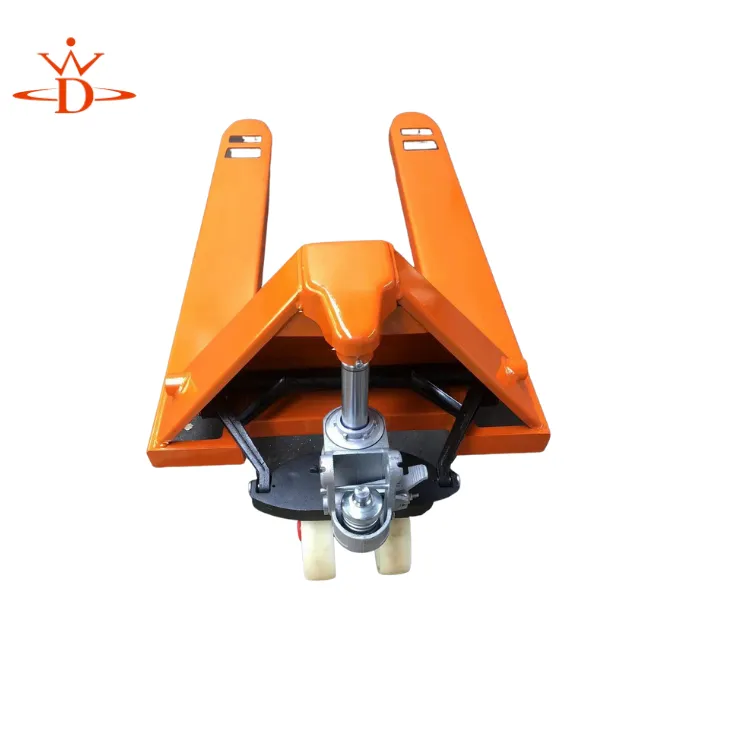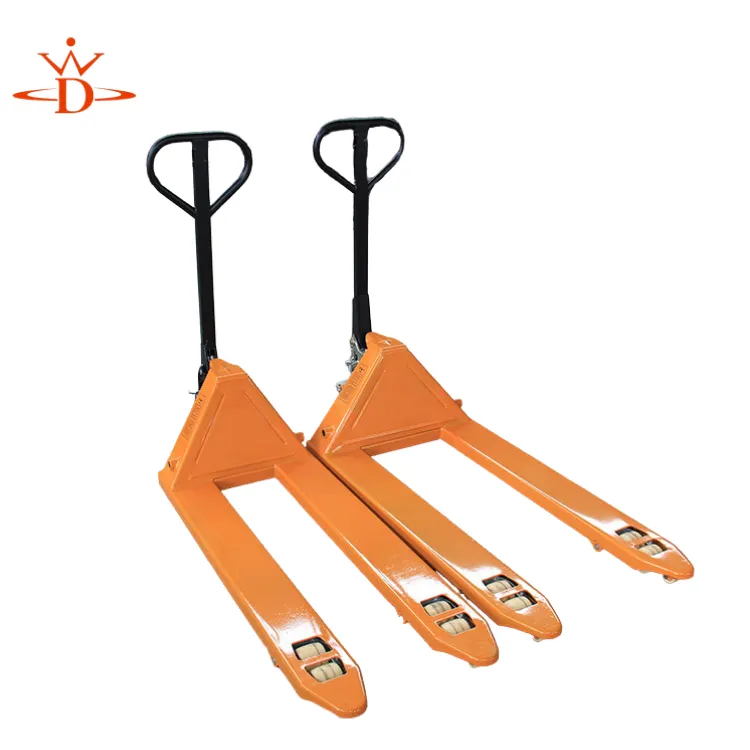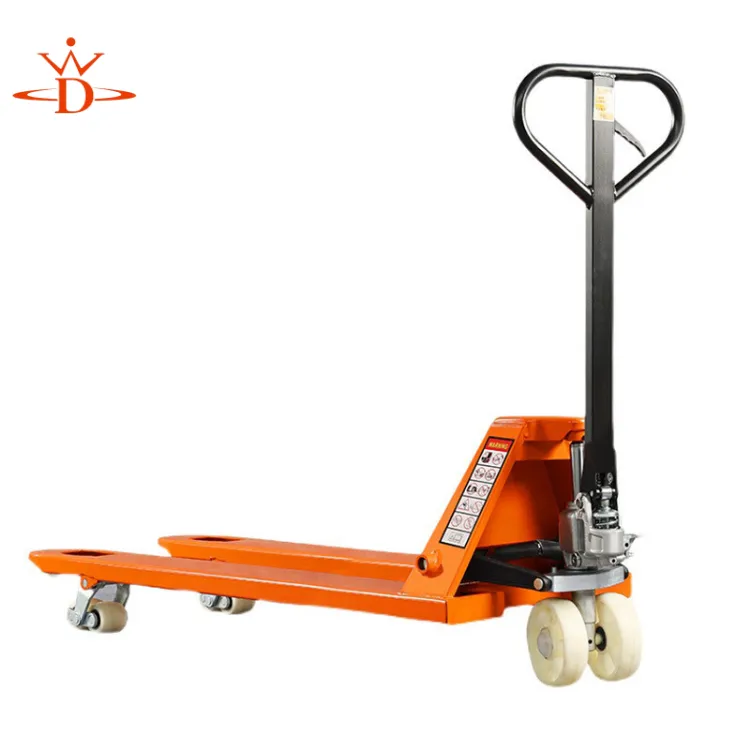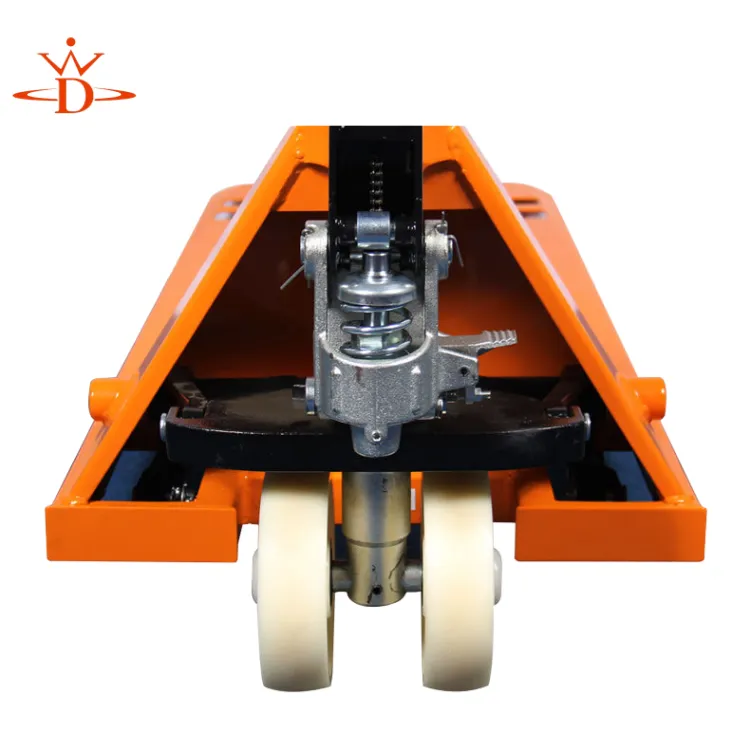Dawei Hand Pallet Truck: 1200mm Fork, 2-5 Ton, Heavy Duty
Navigating the Future: Top Lifting Equipment Manufacturers from China at Bauma China
An Insight for B2B Decision Makers into Advanced Hoisting Solutions
Introduction: Bauma China – A Global Stage for Hoisting Innovation
In the dynamic landscape of global construction machinery, Bauma China stands as an undisputed titan. This premier international trade fair, held biennially, serves as a pivotal platform for industry leaders to showcase groundbreaking advancements and set the pace for future development. For B2B decision-makers in the material handling, construction, and logistics sectors, Bauma China is far more than just an exhibition; it's a strategic hub for identifying partners, evaluating cutting-edge technologies, and understanding the trajectory of the lifting equipment industry.
The sheer scale and depth of innovation displayed at Bauma China underscore its immense value for businesses seeking to enhance operational efficiency, safety, and sustainability. It's where the future of heavy machinery and hoisting solutions is unveiled, attracting thousands of exhibitors and hundreds of thousands of visitors from across the globe. For those specializing in everything from large-scale cranes to essential everyday tools like pallet trucks, the insights gained and connections forged here are invaluable.
This article delves into the transformative trends reshaping the lifting equipment sector and spotlights key Chinese manufacturers, including Hebei Dawei Hoisting Machinery Manufacturing Co., LTD, who are not just participating but leading the charge in delivering advanced, reliable, and cost-effective solutions to a global clientele.
Industry Trend Spotlight: The Digital and Sustainable Evolution of Lifting Equipment
The lifting equipment industry is undergoing a profound transformation, driven by technological advancements and an increasing global demand for smarter, safer, and more sustainable operations. At Bauma China, these shifts are not just discussed; they are demonstrated through tangible innovations that are rapidly gaining global attention.
Key Trends Shaping the Sector:
- Integration of IoT and AI for Predictive Maintenance: Sensors and AI algorithms are revolutionizing equipment management. By continuously monitoring performance data, these systems can predict potential failures, optimize maintenance schedules, and significantly reduce downtime, thereby extending the lifespan of valuable lifting equipment. This proactive approach boosts operational continuity and cost-efficiency.
- Enhanced Safety Features: Worker safety remains paramount. Innovations include advanced collision avoidance systems, intelligent load management, real-time monitoring of operational parameters, and ergonomic designs that minimize human error and fatigue. These features are becoming standard, reflecting a commitment to safeguarding personnel and assets.
- Energy-Efficient Designs: With increasing environmental concerns and rising energy costs, manufacturers are prioritizing eco-friendly solutions. This involves developing lifting equipment that consumes less power, utilizes regenerative braking systems, and incorporates lightweight yet robust materials. Electric and hybrid models are becoming more prevalent across all categories.
- Automation and Remote Control Capabilities: Automation is transforming material handling, especially in repetitive and hazardous tasks. Remote-controlled cranes, automated guided vehicles (AGVs), and robotic assistants are improving precision, speed, and safety on job sites and in warehouses. This also addresses labor shortages and allows for operation in challenging environments.
- Customized Solutions for Specialized Heavy Lifting Applications: The demand for bespoke lifting equipment is growing as projects become more complex and require highly specialized solutions. Manufacturers are offering flexible designs and modular systems that can be tailored to unique operational requirements, from offshore wind farm installation to intricate industrial assembly.
Market Data and Emerging Focus Areas:
The market for material handling and industrial equipment continues its robust expansion. This growth is predominantly fueled by extensive global infrastructure development, rapid manufacturing expansion—particularly in industries like automotive, electronics, and e-commerce—and the accelerating adoption of automation in logistics and production processes. This trend is especially pronounced in Asian and other emerging markets, where urbanization and industrialization are proceeding at an unprecedented pace.
Emerging focus areas for B2B buyers include a heightened emphasis on smart lifting technologies that offer real-time data and actionable insights, unparalleled operational safety standards to protect both workers and investments, superior energy efficiency to reduce operational costs and carbon footprint, and the capability for heavy-duty customization to meet specific project demands. These elements collectively define the competitive edge in today’s lifting equipment market.
Profiles of Leading Lifting Equipment Manufacturers
At Bauma China, a diverse array of manufacturers showcase their prowess, from global giants to specialized local innovators. Here’s a closer look at some of the prominent players shaping the lifting equipment landscape:
Hebei Dawei Hoisting Machinery Manufacturing Co., LTD – Precision and Power in Every Lift
When it comes to reliable and robust lifting equipment, Hebei Dawei Hoisting Machinery Manufacturing Co., LTD stands out as a leading Chinese manufacturer with an impressive track record. With over 20 years of manufacturing experience, Dawei has carved a niche for itself by delivering an extensive product range that covers various hoisting needs, from manual and electric chain hoists to high-capacity industrial cranes and essential material handling solutions like pallet trucks.
The company's unwavering commitment to quality is evident in its adherence to international standards, boasting ISO and CE certifications across its product lines. This focus on quality is backed by proven R&D capabilities, allowing Dawei to continuously innovate and introduce products that meet the evolving demands of industries worldwide. Their engineering teams are dedicated to optimizing performance, enhancing safety, and improving the longevity of every piece of equipment they produce.
Hebei Dawei Hoisting Machinery Manufacturing Co., LTD's global footprint is significant, supported by a robust global export network. They understand the nuances of international trade and provide comprehensive customer service, ensuring seamless support from inquiry to after-sales care. This commitment to customer satisfaction has fostered long-term partnerships with businesses across continents.
Spotlight Product: Dawei Hand Pallet Truck
Among Dawei's extensive offerings, the Dawei Hand Pallet Truck-Fork Length 1200mm, Rated Load 2000-5000 KGS exemplifies their dedication to practical, durable, and efficient material handling. This essential piece of lifting equipment is designed for high-performance and reliability in warehouses, factories, and logistics centers. Its 1200mm fork length provides excellent stability and maneuverability for standard pallets, while a rated load capacity ranging from 2000 to 5000 KGS ensures it can handle a wide variety of loads with ease.
Key features of the Dawei Hand Pallet Truck include its robust hydraulic system for effortless lifting, ergonomic handle design for comfortable operation, and high-quality wheels that ensure smooth movement even under heavy loads. This model is a testament to Dawei's engineering excellence, offering a cost-effective solution for businesses requiring reliable manual lifting and transport capabilities. Its durability and minimal maintenance requirements translate into significant long-term savings for B2B operators.
Dawei Hand Pallet Truck Series




Other Noteworthy Lifting Equipment Manufacturers:
- Konecranes: A global leader in the lifting businesses, Konecranes provides a wide range of cranes, lifting solutions, and services. Known for their advanced technology, digitalization, and commitment to sustainability, they offer products from industrial cranes to heavy-duty port cranes, often showcasing smart features and predictive maintenance capabilities.
- Demag (Terex Material Handling): With a long history of engineering excellence, Demag is renowned for its high-quality industrial cranes, hoists, and components. They are particularly strong in providing customized solutions for challenging industrial applications, emphasizing robustness, precision, and safety in their lifting equipment.
- Zhejiang Sanmen Shunlong Hoisting Equipment Co., Ltd.: A significant player in the Chinese market, Shunlong specializes in various types of manual and electric hoisting equipment, including chain blocks, lever hoists, and trolleys. They focus on manufacturing reliable, cost-effective, and safe products that cater to diverse industrial needs, with a strong presence in both domestic and international markets.
- Nanjing Hoisting Equipment Co., Ltd.: Another prominent Chinese manufacturer, Nanjing Hoisting Equipment offers a comprehensive range of overhead cranes, gantry cranes, electric hoists, and accessories. They are known for their strong R&D, adherence to quality standards, and ability to provide tailored lifting equipment solutions for heavy industry, construction, and logistics.
Market Outlook & Opportunities: The Road Ahead for Lifting Equipment
The global lifting equipment market is poised for continued growth, driven by an expanding global economy and ongoing industrialization. B2B buyers and decision-makers are increasingly looking for solutions that offer more than just brute strength; they demand intelligence, efficiency, and sustainability. The upcoming trends suggest a clear move towards integrating advanced technologies into every aspect of lifting operations.
Buyer demand is shifting towards equipment that can provide real-time data for better management, minimize operational costs through energy efficiency, and ensure higher levels of safety for personnel and cargo. This includes a growing preference for modular and adaptable systems that can be easily integrated into existing infrastructure or scaled for future needs.
Key Opportunities for Businesses:
- Automation: The increasing cost of labor and the push for higher productivity will continue to drive investments in automated lifting equipment. This includes AGVs, automated storage and retrieval systems (AS/RS), and remotely operated cranes that can work in conjunction with minimal human intervention.
- Smart Manufacturing: As factories evolve into smart, interconnected environments, lifting equipment will become an integral part of the Industrial Internet of Things (IIoT). This means more sophisticated sensors, data analytics, and integration with enterprise resource planning (ERP) systems for seamless operation and predictive maintenance.
- Sustainability: Beyond energy efficiency, sustainability encompasses the entire lifecycle of lifting equipment, from eco-friendly manufacturing processes to recyclable materials and reduced emissions. Companies that prioritize green solutions will gain a significant competitive advantage as global environmental regulations tighten and corporate social responsibility becomes more prominent.
- Service and Maintenance Innovations: The aftermarket for parts, service, and maintenance will grow alongside equipment sales. Opportunities exist for manufacturers and service providers to offer advanced service contracts, remote diagnostics, and condition-based maintenance programs.
Chinese manufacturers, with their strong focus on R&D and manufacturing scale, are exceptionally well-positioned to capitalize on these trends, offering innovative yet competitive solutions to the global market.
Buyer/Business Takeaways: Strategic Investments in Lifting Equipment
For B2B decision-makers, investing in the right lifting equipment is not merely an operational expenditure; it's a strategic move that can significantly impact productivity, safety, and profitability. The advanced solutions showcased at Bauma China highlight why now is a crucial time to re-evaluate and upgrade your material handling capabilities.
Why Investing in Modern Lifting Equipment Makes Sense:
- Increased Efficiency: Modern lifting equipment, especially automated and semi-automated systems, can perform tasks faster and with greater precision, reducing cycle times and boosting overall operational throughput.
- Enhanced Safety: With advanced safety features like anti-collision systems, overload protection, and ergonomic designs, the risk of accidents and injuries is significantly minimized, protecting both personnel and valuable assets.
- Cost Savings: Energy-efficient designs, predictive maintenance capabilities, and reduced manual labor requirements all contribute to lower operational costs over the long term. Durable equipment from reputable manufacturers also means fewer replacements and repairs.
- Data-Driven Decisions: Integrated IoT and AI provide invaluable data on equipment performance, utilization, and maintenance needs, enabling businesses to make informed decisions for optimization and future investments.
Tips for Adopting or Partnering with Chinese Manufacturers:
- Due Diligence is Key: Thoroughly research potential partners. Look for certifications (ISO, CE), manufacturing experience, R&D capabilities, and strong export track records, like those demonstrated by Hebei Dawei Hoisting Machinery Manufacturing Co., LTD.
- Clear Communication: Establish clear communication channels and expectations regarding product specifications, delivery timelines, quality control, and after-sales support.
- Focus on Long-Term Value: While cost-effectiveness is a benefit, prioritize total cost of ownership (TCO) which includes durability, maintenance, energy consumption, and support.
- Leverage Technology: Inquire about integrated smart features, automation readiness, and customization options to ensure the equipment aligns with your future operational needs.
Future-Proof Strategies:
To future-proof your operations, consider modular and scalable lifting equipment solutions that can adapt to changing demands. Invest in training your workforce to handle advanced technologies, and foster partnerships with manufacturers who offer continuous innovation and robust support. Embrace digitalization to gain a competitive edge, ensuring your lifting equipment infrastructure is ready for the challenges and opportunities of tomorrow.
Conclusion: Shaping the Global Lifting Equipment Market
Bauma China remains an indispensable event for anyone involved in the lifting equipment industry. It not only showcases the latest technological marvels but also acts as a barometer for market trends and a catalyst for global partnerships. Chinese manufacturers, exemplified by the innovation and reliability of Hebei Dawei Hoisting Machinery Manufacturing Co., LTD, are playing a crucial role in shaping the future of this vital sector.
Their dedication to quality, R&D, and customer-centric solutions—such as the highly efficient Dawei Hand Pallet Truck-Fork Length 1200mm, Rated Load 2000-5000 KGS—offers B2B decision-makers compelling reasons to explore partnerships and adopt their advanced lifting equipment. As industries continue to evolve, seeking smarter, safer, and more sustainable operational solutions, the contributions from these manufacturers will be more critical than ever.
To learn more about high-quality, reliable manual material handling solutions, including the featured pallet truck, visit:
Explore Dawei Hand Pallet TrucksNavigating the Future: Top Lifting Equipment Manufacturers from China at Bauma China
An Insight for B2B Decision Makers into Advanced Hoisting Solutions
Introduction: Bauma China – A Global Stage for Hoisting Innovation
In the dynamic landscape of global construction machinery, Bauma China stands as an undisputed titan. This premier international trade fair, held biennially, serves as a pivotal platform for industry leaders to showcase groundbreaking advancements and set the pace for future development. For B2B decision-makers in the material handling, construction, and logistics sectors, Bauma China is far more than just an exhibition; it's a strategic hub for identifying partners, evaluating cutting-edge technologies, and understanding the trajectory of the lifting equipment industry.
The sheer scale and depth of innovation displayed at Bauma China underscore its immense value for businesses seeking to enhance operational efficiency, safety, and sustainability. It's where the future of heavy machinery and hoisting solutions is unveiled, attracting thousands of exhibitors and hundreds of thousands of visitors from across the globe. For those specializing in everything from large-scale cranes to essential everyday tools like pallet trucks, the insights gained and connections forged here are invaluable.
This article delves into the transformative trends reshaping the lifting equipment sector and spotlights key Chinese manufacturers, including Hebei Dawei Hoisting Machinery Manufacturing Co., LTD, who are not just participating but leading the charge in delivering advanced, reliable, and cost-effective solutions to a global clientele.
Industry Trend Spotlight: The Digital and Sustainable Evolution of Lifting Equipment
The lifting equipment industry is undergoing a profound transformation, driven by technological advancements and an increasing global demand for smarter, safer, and more sustainable operations. At Bauma China, these shifts are not just discussed; they are demonstrated through tangible innovations that are rapidly gaining global attention.
Key Trends Shaping the Sector:
- Integration of IoT and AI for Predictive Maintenance: Sensors and AI algorithms are revolutionizing equipment management. By continuously monitoring performance data, these systems can predict potential failures, optimize maintenance schedules, and significantly reduce downtime, thereby extending the lifespan of valuable lifting equipment. This proactive approach boosts operational continuity and cost-efficiency.
- Enhanced Safety Features: Worker safety remains paramount. Innovations include advanced collision avoidance systems, intelligent load management, real-time monitoring of operational parameters, and ergonomic designs that minimize human error and fatigue. These features are becoming standard, reflecting a commitment to safeguarding personnel and assets.
- Energy-Efficient Designs: With increasing environmental concerns and rising energy costs, manufacturers are prioritizing eco-friendly solutions. This involves developing lifting equipment that consumes less power, utilizes regenerative braking systems, and incorporates lightweight yet robust materials. Electric and hybrid models are becoming more prevalent across all categories.
- Automation and Remote Control Capabilities: Automation is transforming material handling, especially in repetitive and hazardous tasks. Remote-controlled cranes, automated guided vehicles (AGVs), and robotic assistants are improving precision, speed, and safety on job sites and in warehouses. This also addresses labor shortages and allows for operation in challenging environments.
- Customized Solutions for Specialized Heavy Lifting Applications: The demand for bespoke lifting equipment is growing as projects become more complex and require highly specialized solutions. Manufacturers are offering flexible designs and modular systems that can be tailored to unique operational requirements, from offshore wind farm installation to intricate industrial assembly.
Market Data and Emerging Focus Areas:
The market for material handling and industrial equipment continues its robust expansion. This growth is predominantly fueled by extensive global infrastructure development, rapid manufacturing expansion—particularly in industries like automotive, electronics, and e-commerce—and the accelerating adoption of automation in logistics and production processes. This trend is especially pronounced in Asian and other emerging markets, where urbanization and industrialization are proceeding at an unprecedented pace.
Emerging focus areas for B2B buyers include a heightened emphasis on smart lifting technologies that offer real-time data and actionable insights, unparalleled operational safety standards to protect both workers and investments, superior energy efficiency to reduce operational costs and carbon footprint, and the capability for heavy-duty customization to meet specific project demands. These elements collectively define the competitive edge in today’s lifting equipment market.
Profiles of Leading Lifting Equipment Manufacturers
At Bauma China, a diverse array of manufacturers showcase their prowess, from global giants to specialized local innovators. Here’s a closer look at some of the prominent players shaping the lifting equipment landscape:
Hebei Dawei Hoisting Machinery Manufacturing Co., LTD – Precision and Power in Every Lift
When it comes to reliable and robust lifting equipment, Hebei Dawei Hoisting Machinery Manufacturing Co., LTD stands out as a leading Chinese manufacturer with an impressive track record. With over 20 years of manufacturing experience, Dawei has carved a niche for itself by delivering an extensive product range that covers various hoisting needs, from manual and electric chain hoists to high-capacity industrial cranes and essential material handling solutions like pallet trucks.
The company's unwavering commitment to quality is evident in its adherence to international standards, boasting ISO and CE certifications across its product lines. This focus on quality is backed by proven R&D capabilities, allowing Dawei to continuously innovate and introduce products that meet the evolving demands of industries worldwide. Their engineering teams are dedicated to optimizing performance, enhancing safety, and improving the longevity of every piece of equipment they produce.
Hebei Dawei Hoisting Machinery Manufacturing Co., LTD's global footprint is significant, supported by a robust global export network. They understand the nuances of international trade and provide comprehensive customer service, ensuring seamless support from inquiry to after-sales care. This commitment to customer satisfaction has fostered long-term partnerships with businesses across continents.
Spotlight Product: Dawei Hand Pallet Truck
Among Dawei's extensive offerings, the Dawei Hand Pallet Truck-Fork Length 1200mm, Rated Load 2000-5000 KGS exemplifies their dedication to practical, durable, and efficient material handling. This essential piece of lifting equipment is designed for high-performance and reliability in warehouses, factories, and logistics centers. Its 1200mm fork length provides excellent stability and maneuverability for standard pallets, while a rated load capacity ranging from 2000 to 5000 KGS ensures it can handle a wide variety of loads with ease.
Key features of the Dawei Hand Pallet Truck include its robust hydraulic system for effortless lifting, ergonomic handle design for comfortable operation, and high-quality wheels that ensure smooth movement even under heavy loads. This model is a testament to Dawei's engineering excellence, offering a cost-effective solution for businesses requiring reliable manual lifting and transport capabilities. Its durability and minimal maintenance requirements translate into significant long-term savings for B2B operators.
Dawei Hand Pallet Truck Series




Other Noteworthy Lifting Equipment Manufacturers:
- Konecranes: A global leader in the lifting businesses, Konecranes provides a wide range of cranes, lifting solutions, and services. Known for their advanced technology, digitalization, and commitment to sustainability, they offer products from industrial cranes to heavy-duty port cranes, often showcasing smart features and predictive maintenance capabilities.
- Demag (Terex Material Handling): With a long history of engineering excellence, Demag is renowned for its high-quality industrial cranes, hoists, and components. They are particularly strong in providing customized solutions for challenging industrial applications, emphasizing robustness, precision, and safety in their lifting equipment.
- Zhejiang Sanmen Shunlong Hoisting Equipment Co., Ltd.: A significant player in the Chinese market, Shunlong specializes in various types of manual and electric hoisting equipment, including chain blocks, lever hoists, and trolleys. They focus on manufacturing reliable, cost-effective, and safe products that cater to diverse industrial needs, with a strong presence in both domestic and international markets.
- Nanjing Hoisting Equipment Co., Ltd.: Another prominent Chinese manufacturer, Nanjing Hoisting Equipment offers a comprehensive range of overhead cranes, gantry cranes, electric hoists, and accessories. They are known for their strong R&D, adherence to quality standards, and ability to provide tailored lifting equipment solutions for heavy industry, construction, and logistics.
Market Outlook & Opportunities: The Road Ahead for Lifting Equipment
The global lifting equipment market is poised for continued growth, driven by an expanding global economy and ongoing industrialization. B2B buyers and decision-makers are increasingly looking for solutions that offer more than just brute strength; they demand intelligence, efficiency, and sustainability. The upcoming trends suggest a clear move towards integrating advanced technologies into every aspect of lifting operations.
Buyer demand is shifting towards equipment that can provide real-time data for better management, minimize operational costs through energy efficiency, and ensure higher levels of safety for personnel and cargo. This includes a growing preference for modular and adaptable systems that can be easily integrated into existing infrastructure or scaled for future needs.
Key Opportunities for Businesses:
- Automation: The increasing cost of labor and the push for higher productivity will continue to drive investments in automated lifting equipment. This includes AGVs, automated storage and retrieval systems (AS/RS), and remotely operated cranes that can work in conjunction with minimal human intervention.
- Smart Manufacturing: As factories evolve into smart, interconnected environments, lifting equipment will become an integral part of the Industrial Internet of Things (IIoT). This means more sophisticated sensors, data analytics, and integration with enterprise resource planning (ERP) systems for seamless operation and predictive maintenance.
- Sustainability: Beyond energy efficiency, sustainability encompasses the entire lifecycle of lifting equipment, from eco-friendly manufacturing processes to recyclable materials and reduced emissions. Companies that prioritize green solutions will gain a significant competitive advantage as global environmental regulations tighten and corporate social responsibility becomes more prominent.
- Service and Maintenance Innovations: The aftermarket for parts, service, and maintenance will grow alongside equipment sales. Opportunities exist for manufacturers and service providers to offer advanced service contracts, remote diagnostics, and condition-based maintenance programs.
Chinese manufacturers, with their strong focus on R&D and manufacturing scale, are exceptionally well-positioned to capitalize on these trends, offering innovative yet competitive solutions to the global market.
Buyer/Business Takeaways: Strategic Investments in Lifting Equipment
For B2B decision-makers, investing in the right lifting equipment is not merely an operational expenditure; it's a strategic move that can significantly impact productivity, safety, and profitability. The advanced solutions showcased at Bauma China highlight why now is a crucial time to re-evaluate and upgrade your material handling capabilities.
Why Investing in Modern Lifting Equipment Makes Sense:
- Increased Efficiency: Modern lifting equipment, especially automated and semi-automated systems, can perform tasks faster and with greater precision, reducing cycle times and boosting overall operational throughput.
- Enhanced Safety: With advanced safety features like anti-collision systems, overload protection, and ergonomic designs, the risk of accidents and injuries is significantly minimized, protecting both personnel and valuable assets.
- Cost Savings: Energy-efficient designs, predictive maintenance capabilities, and reduced manual labor requirements all contribute to lower operational costs over the long term. Durable equipment from reputable manufacturers also means fewer replacements and repairs.
- Data-Driven Decisions: Integrated IoT and AI provide invaluable data on equipment performance, utilization, and maintenance needs, enabling businesses to make informed decisions for optimization and future investments.
Tips for Adopting or Partnering with Chinese Manufacturers:
- Due Diligence is Key: Thoroughly research potential partners. Look for certifications (ISO, CE), manufacturing experience, R&D capabilities, and strong export track records, like those demonstrated by Hebei Dawei Hoisting Machinery Manufacturing Co., LTD.
- Clear Communication: Establish clear communication channels and expectations regarding product specifications, delivery timelines, quality control, and after-sales support.
- Focus on Long-Term Value: While cost-effectiveness is a benefit, prioritize total cost of ownership (TCO) which includes durability, maintenance, energy consumption, and support.
- Leverage Technology: Inquire about integrated smart features, automation readiness, and customization options to ensure the equipment aligns with your future operational needs.
Future-Proof Strategies:
To future-proof your operations, consider modular and scalable lifting equipment solutions that can adapt to changing demands. Invest in training your workforce to handle advanced technologies, and foster partnerships with manufacturers who offer continuous innovation and robust support. Embrace digitalization to gain a competitive edge, ensuring your lifting equipment infrastructure is ready for the challenges and opportunities of tomorrow.
Conclusion: Shaping the Global Lifting Equipment Market
Bauma China remains an indispensable event for anyone involved in the lifting equipment industry. It not only showcases the latest technological marvels but also acts as a barometer for market trends and a catalyst for global partnerships. Chinese manufacturers, exemplified by the innovation and reliability of Hebei Dawei Hoisting Machinery Manufacturing Co., LTD, are playing a crucial role in shaping the future of this vital sector.
Their dedication to quality, R&D, and customer-centric solutions—such as the highly efficient Dawei Hand Pallet Truck-Fork Length 1200mm, Rated Load 2000-5000 KGS—offers B2B decision-makers compelling reasons to explore partnerships and adopt their advanced lifting equipment. As industries continue to evolve, seeking smarter, safer, and more sustainable operational solutions, the contributions from these manufacturers will be more critical than ever.
To learn more about high-quality, reliable manual material handling solutions, including the featured pallet truck, visit:
Explore Dawei Hand Pallet Trucks-
Dawei Hand Pallet Truck 1200mm, 2000–5000 KGS Heavy-DutyNewsNov.17,2025
-
Dawei Hand Pallet Truck, Fork Length 1200mm, 2000–5000kgNewsNov.17,2025
-
Large Equipment Movers – Safe, Insured & On-Time ServiceNewsNov.17,2025
-
Machine Moving Dollies | Heavy-Duty, Low-Profile, SafeNewsNov.17,2025
-
Permanent Lifting Magnet - Heavy-Duty, Safe, Quick ReleaseNewsNov.11,2025
-
PML 1000 Lifting Magnet - Heavy-Duty, Safe, No PowerNewsNov.11,2025
-
Large Equipment Movers: Safe, Fast, Certified ProsNewsNov.11,2025
